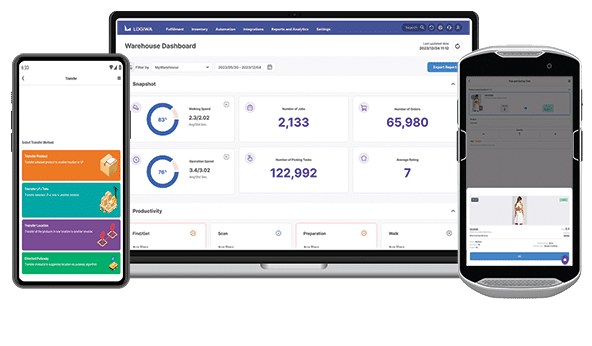Proper warehouse and inventory management is necessary for reaching these goals. And proper management isn’t possible without warehouse inventory management software.
Warehouse management software keeps track of the inventory and operations of an organization. To understand why your business needs warehouse inventory management software and to learn what’s necessary to implement it, keep reading this guide.
We’ll dive deep into the ins and outs of warehouse inventory management software and how it can help your business, no matter how big or small your operations may be.
Key Takeaways
- Warehouse management includes the handling inventory and all the various processes within a warehouse facility, while inventory management focuses on stock operations.
- Warehouse inventory management software helps optimize inventory handling processes, including receiving, putaway, picking and packing, and invoicing.
- Warehouse inventory management software tracks the items through its entire life cycle within a warehouse using a variety of technologies, including automatic identification and data capture (AIDC) technology.
- Some key benefits of using warehouse inventory management software include: better metric tracking, the ability to maintain just-in-time inventory, enhanced security, optimized inbound and outbound operations, improved employee morale and higher customer satisfaction.
- When choosing a warehouse inventory management solution, look for: high levels of configurability, real-time visibility, competitive automation capabilities, time-to-value and cost efficiency.
Contents
- What Is Warehouse Management?
- What Is Inventory Management?
- How Warehouse and Inventory Management Software Can Enhanced Operations
- How Warehouse and Inventory Management Software Can Track Metrics
- 5 Additional Benefits of Warehouse Inventory Management Software
- How to Choose Warehouse Inventory Management Software
- Warehouse Inventory Management FAQs
What Is Warehouse Management?
If you’re reading this, you probably aren’t new to the concept of warehouse management. The official definition is managing stock, employees, picking and packing processes, loading, and return processes. Optimal warehouse management means managing all of this (and more) at maximum efficiency.
For example, planning the stock location for the most efficient picking and packing is one small part of warehouse management. Looking at these processes as a whole is the definition of warehouse management.
What Is Inventory Management?
Inventory management is similar to warehouse management but instead deals with specific goods processed by the warehouse. A rudimentary example in a food facility is FIFO, or first in, first out. Warehouse staff know to use the oldest raw ingredients first to maximize shelf life.
Differences Between Warehouse Management & Inventory Management
Inventory management is a key component of warehouse management, but there is a distinct difference between these two processes. Warehouse management includes the handling of inventory and all the various tasks within a warehouse facility, including receiving and putaway (of new items and returns), as well as order picking, sorting, packing and shipping operations.
Inventory management deals strictly with stock, including ordering, storing, moving and selling products. It can also include forecasting demand and replenishment, which leads to smoother warehouse and supply chain operations.
How Warehouse and Inventory Management Software Can Enhance Operations
Managing and handling inventory may seem like an easy job to the untrained eye, but we know how complicated a job it actually is. From the moment items arrive at your loading dock to the moment they leave for customer delivery, there are many steps and people involved and many opportunities for error.
All these steps, employees, and potential errors cost valuable time and money, neither of which can be spared as the demand for ecommerce continues to grow.
With customized warehouse inventory management software, you can build systems that optimize your inventory handling processes, including receiving, putaway, picking and packing, and invoicing. You can also maximize employee efficiency, reduce costs, and allow your operations to grow.
Scaling is a huge part of warehouse operations today, and it’s difficult to do without the correct end-to-end solution that can do it all.
How Does Warehouse Inventory Management Software Work?
Warehouse inventory management software tracks the items through their entire life cycle within a warehouse. Using a variety of technologies, including automatic identification and data capture (AIDC) technology, items can be tracked and accounted for with high levels of accuracy.
Warehouse inventory management systems can track the flow of product as they enter, leave or move within a warehouse. In addition, AI-powered features like directed putaway and modern automation features give operators the ability to optimize item allocation to streamline fulfillment and maximize cost-efficiency of operations.
Integrating Your Current Software With New Software
Perhaps you’ve already integrated some technology into your warehouse operations and inventory management processes, such as barcode scanners, labelers, scales, or even self-loading conveyors.
With good warehouse inventory management software, you can integrate the tools you already use into the system to increase accuracy and improve your operations. For example:
- Barcode scanners can quickly match barcode numbers with those already in your system, ensuring the correct item is picked for an order.
- Labelers can automatically print packing slips or mailing labels once an order is picked and packed.
- Scales can provide the exact weight of an item and work with your WMS to find the best shipping rate from approved carriers in your system.
- Self-loading conveyors can deliver items to packing stations to speed up the time it takes to get an order out the door.
How Warehouse and Inventory Management Software Can Help Track Metrics
No matter what type of customers you serve, you want to be at the top of your game. But how can you improve if you don’t know where you stand right now? What if you don’t have the visibility to see valuable stats that can help you improve and scale your processes?
Warehouse inventory management relies heavily on data, and it’s valuable! You can use that data to make your processes better and save money. Manual data tracking can provide some helpful information, but it may not be able to provide the right data.
Automating processes and using warehouse management software to track processes within your warehouse can help you set goals and key performance indicators (KPIs), building an organizational mindset of continuous learning and improvement.
It also helps you get a leg up on competitors that don’t have that visibility into their data. Think about it: If you had X-ray vision goggles and no one else did, what would you see that they couldn’t? Better warehouse inventory management software solutions give you this kind of visibility into KPIs that some warehouses aren’t aware they should even be tracking.
Inventory Management KPIs
KPIs for warehouse operations cover everything from receiving to shipping and backorders to returns. Inventory reports in your warehouse are grounded in warehouse best practices and the most frequently used KPIs. Warehouse management KPIs fall into seven categories:
- Receiving and putaway: Get insight into where your processes are performing well and where they need some help.
- Shipping: KPIs in this area include order cycle time and insight into issues in picking, packing, or shipping workflows.
- Storage: Find out how much it costs to keep products on your shelves.
- Picking: Calculate your order picking accuracy, reduce fulfillment issues, and get better insights into available inventory.
- Equipment: Learn how efficiently you use warehouse equipment.
- Return process: Improve your rate of order returns and how quickly items are returned to shelves.
- Safety: Track the number of incidents and lost time, and evaluate workflows and processes to improve your safety standards for employees.

5 Additional Benefits of Warehouse Inventory Management Software
In addition to using data and KPIs to improve your warehouse operations and save money, you may be wondering what some of the other benefits of a WMS might be. Let’s explore five of these additional benefits.
#1. Just-in-Time Inventory
Just-in-time is an inventory management practice that keeps stock levels low and moves products quickly through your warehouse. This inventory management practice can reduce storage costs, but it does take some practice.
You’ll need accurate demand forecasting capabilities, which your WMS can provide, to generate optimal inventory levels to meet demand without underestimating or exceeding those demands.
#2. Enhanced Security
Setting up your WMS to require all employees to have individual accounts when entering transactions creates a data trail that connects specific employees to specific transactions.
This can improve accountability, allow you to track error rates, and reduce theft risk. You can also identify training opportunities and ways to improve warehouse practices based on the data.
#3. Inbound and Outbound Optimization
With warehouse inventory management software, you can optimize how inventory and equipment move around your warehouse. You can easily schedule receiving and putaway tasks and determine the best dates and times to receive shipments based on available labor and equipment.
Once an order is ready to be picked, you can plan walking routes and establish zone, batch, or wave-picking algorithms.
#4. Improved Employee Morale
It’s hard to work in a chaotic environment. A WMS can reduce that chaos by ensuring operations run smoothly and seamlessly and that your employees use their time wisely. If employees are confident and comfortable performing tasks, productivity and job satisfaction increase, and safety within your warehouse will improve.
#5. Happy Customers and Suppliers
A cloud-based WMS gives suppliers and customers visibility into the available product, the ability to schedule deliveries to your warehouse for slower times, quicker order fulfillment, reduced delivery times, and fewer inaccuracies in shipped orders.
How to Choose Warehouse Inventory Management Software
Whether you’re a small operation or manage multiple warehouses, having accurate and current knowledge of your inventory, process efficiency, and operational costs is essential.
For small- to medium-sized businesses, warehouse inventory management software can help reduce fulfillment error rates, manage inventory throughout your inbound and outbound processes, create effective billing systems, and improve customer service.
For any warehouse operator involved in business-to-business, business-to-customer, or direct-to-customer fulfillment operations, a WMS allows you to serve your clients more effectively and efficiently by automating and streamlining your operations, improving productivity, monitoring jobs and workflow from virtually anywhere, and generating reports to monitor and improve inefficiencies.
If you’re involved in third-party logistics (3PL), you can integrate 3PL software into your WMS software to set up digital warehousing, connect to ecommerce and order management systems and online marketplaces, and establish smart shipping processes to save time and money.
Integrations with popular shipping, accounting, EDI, and robotics systems are easy to set up for all business types to keep your business running smoothly.
If you’re worried about downtime as you build and implement warehouse inventory management software for your business, know that Logiwa can have you set up in as little as four weeks, not the months it can take some of the other software providers.
When choosing a warehouse inventory management solution, look for:
- High levels of configurability to meet your specific operational requirements, especially if you are a 3PL managing multiple clients with different inventory needs
- Real-time visibility for maintaining high-efficiency warehouse performance and avoiding disruptions to fulfillment operations
- Competitive automation capabilities (i.g. Directed putaway, replenishment, smart order picking, dimensioning, etc.)
- Time-to-value and cost efficiency for ensuring a return on investment
Warehouse Inventory Management Best Practices
Strategic warehouse inventory management can take your operations to the next level and ensure long-term success, but it takes proactive facility planning and inventory analysis. Here are a few of Logiwa’s best practices for getting the most out of your warehouse inventory management software:
- Ensure your warehouse (and inventory) are organized using efficient categories. This simplifies operations and helps your warehouse inventory management solution streamline operations.
- Validate inventory data using your sales records, physical counts or by adopting barcode or RFID tracking systems. Your software can only work efficiently if it has accurate data to start with.
- Leverage automation rules to keep inventory organized, improve labor efficiency and maximize throughput without sacrificing accuracy or speed.
- Take advantage of data analytics, which can help you predict demand, maintain appropriate inventory levels, root out inefficiencies and make informed decisions.
For more insights, check out Logiwa’s blog, “Best Practices in Perpetual Inventory Management.”
Bring Your Warehouse to the Next Level With Logiwa WMS
From the moment stock arrives at your loading dock to the moment it arrives at a customer’s doorstep, it’s imperative to know where inventory is at all times, how it’s being handled, and how much your inbound and outbound processes cost.
Manual processes can be full of errors, resulting in unhappy clients, low employee morale, and frustrated customers. A digital, cloud-based warehouse inventory management software will give you complete insight into your inventory at all times.
As a result, you can establish processes based on industry best practices, see increased sales, improve efficiency, and reduce costs. Logiwa WMS is an all-in-one warehouse and inventory management software that enables you to eliminate manual processes and streamline warehouse processes.
Request a demo of Logiwa WMS today to learn more.
Warehouse Inventory Management FAQs
How Can Warehouse Inventory Management Software Improve My Operations?
With customized warehouse software, you can build systems that optimize your inventory handling processes, including receiving, putaway, picking and packing, and invoicing. Plus, software can help maximize employee efficiency, reduce costs, and grow your operations.
Can Other Tech Tools Integrate With a WMS?
Yes! With good WMS software, you can integrate the tools you already use into the system to increase accuracy and improve your operations. Tools you can integrate with a WMS include barcode scanners, labelers, scales, and self-loading conveyor belts, among others.
I Run a Smaller Warehouse Operation, Do I Need a WMS?
Warehouse inventory management software is perfect for small businesses, especially those with plans to grow in the future. WMS software can help reduce fulfillment error rates, manage inventory throughout your inbound and outbound processes, create effective billing systems, and improve customer service.
How Can a WMS Help Me Improve My Operations?
By establishing key performance indicators (KPIs), you can monitor and track warehouse processes and build systems for improvement. Standard warehouse inventory management KPIs include receiving and putaway efficiency, picking accuracy, storage costs, and even warehouse safety.
Tracking KPIs can help improve your warehouse efficiency, reduce costs, and increase client and customer satisfaction.






